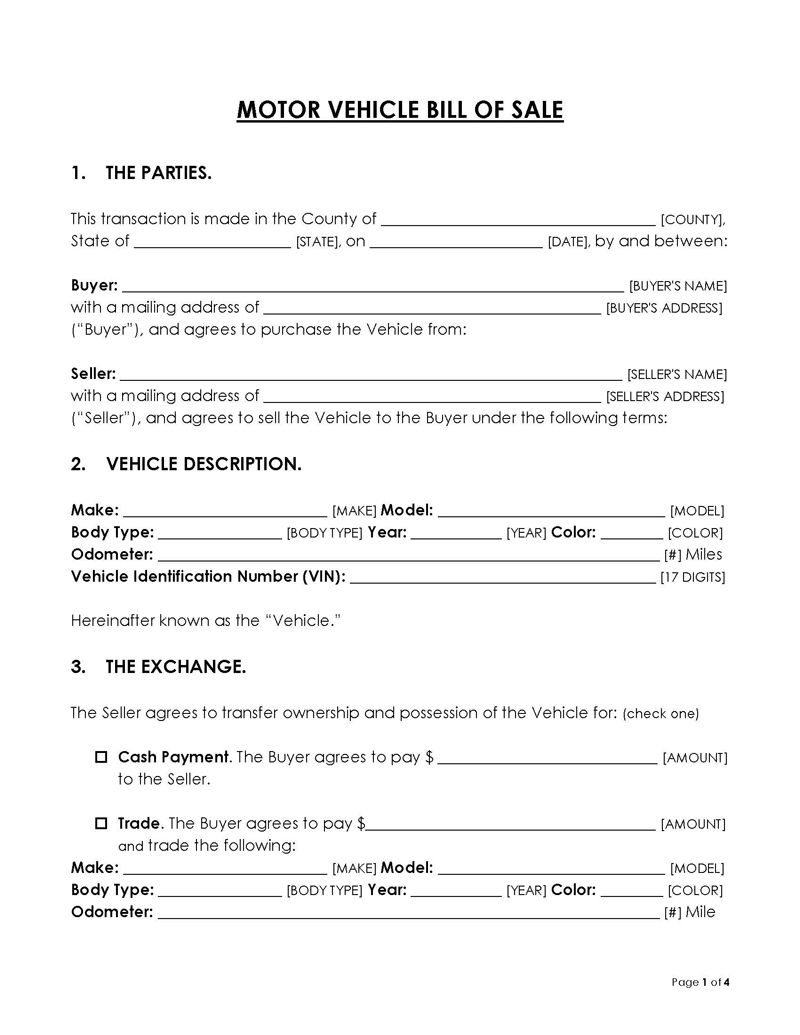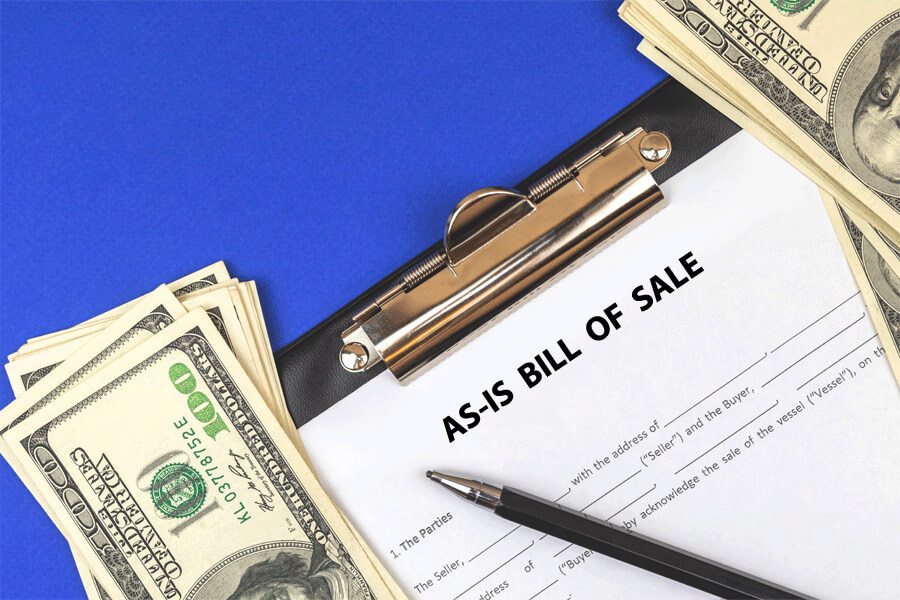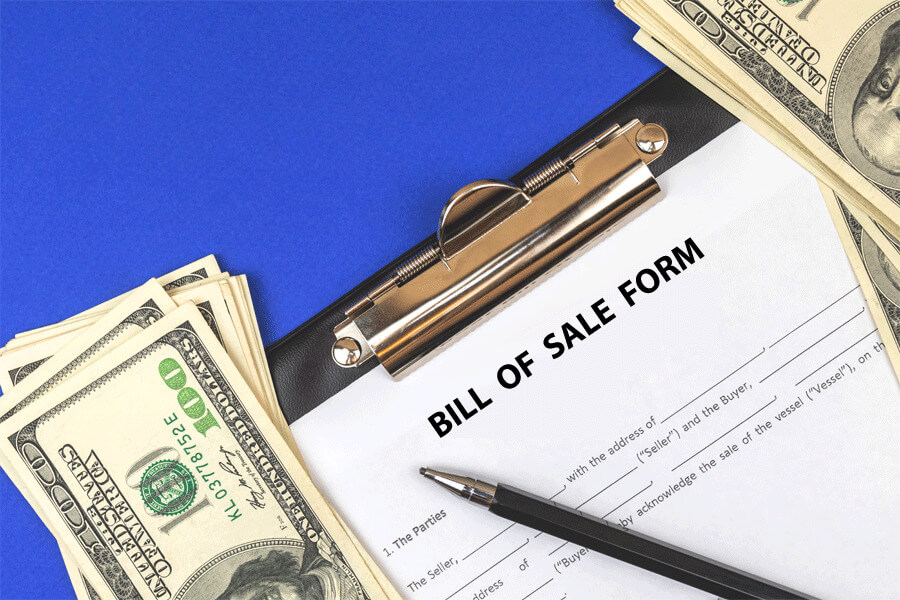The DMV (Department of Motor Vehicles) bill of sale is a form that is used to prove ownership of a vehicle when transferring ownership to another person. This can involve anything from a private sale transaction to a trade-in or donated vehicle. Once completed and signed by both the seller and the buyer, the bill of sale is then submitted to the appropriate Department of Motor Vehicles for approval.
When looking to transfer your vehicle’s ownership, it is important to know what a DMV bill of sale is, why it is required, and what information is needed to complete the form. This article provides comprehensive information on bill of sale requirements and a comprehensive list of all the required and optional items to complete your bill of sale. We will also provide you with free downloadable forms that you can download, customize, and use when you want to transfer your vehicle’s ownership.
Free Forms

DMV bill of sale forms by state
Why is It Needed?
A bill of sale for DVM is a form required for any vehicle sale, trade, or transfer. This legal form aims to ensure that the sale and transfer of ownership from one party to another are conducted legally and with appropriate documents. Furthermore, these documents are used to establish proof of ownership, which is required in most states when ownership is transferred so that the DMV can properly reflect these changes in their records.
In some instances, it can be used to secure a loan. This is naturally the case when an individual sells their car but needs a loan for a new one. Banks and other financial institutions will often use the evidence of the bill of sale to ensure that the buyer has a clear title to the vehicle and that there are no outstanding loans or liens on the vehicle. This is because many lenders will not allow an individual to take out a loan if they do not have proof of a free and clear title.
This is important to both the buyer and the seller in a transfer of ownership. The buyer wishes to ensure that they are purchasing a vehicle from an authorized dealer. It will help you provide proof of ownership and help you claim any damages that were not disclosed during the time of the sale. It serves to protect the buyer should the seller deny the sale at any point.
It also helps decide whether the buyer can register and then help title the vehicle once it has been transferred. It also acts as a receipt and releases the seller from any liability after the sale. The seller can also use it as an official document that states that the ownership of the car they are selling has been transferred. This form can be used by both the seller and the buyer in the event of a dispute arising from the transfer of ownership of the vehicle.
Where Can You Find the Bill of Sale?
It is available online in most states and can be found by researching your local DMV website. Contact your local DMV office and request a copy of the form if it is not readily available online. The form will usually cost a small fee; however, most DMVs will charge no more than $10 per form.
When buying or selling a vehicle, some states typically demand that only certain forms offered by the local motor agency be used. To ensure that you are using the correct form, be sure to check with your local DMV offices. In states where no specifications are provided on which forms to use, you can simply draft a bill of sale on MS Word. You can also use premade templates to help ensure that you do not leave out any important information.
Items to Include
The bill of sale is not an overly detailed form, and the basic information required will usually be on the first page. It is important to know what information to include when completing your bill of sale, as this form can impact your ownership claim.
The items that you will need to complete your bill of sale include the following:
Buyer’s contact information
The first item that should be completed is the buyer’s contact information. The buyer will need to provide their full name, address, phone number, and email address. In case the DMV needs to look into the transaction further, the buyer must include their social security number or other forms of identification.
Seller’s contact information
Next, include the seller’s contact information. This includes the seller’s full name, address, phone number, and email address. The seller may also want to include if they have any special registration requirements or if they have already registered the vehicle through the DMV. If the DMV needs to look into the transaction more thoroughly, the seller’s social security number should be provided as well.
Description of the vehicle
After including the seller’s contact information, including the description of the vehicle. This comprises the make, model, and year of the vehicle. Both parties must be completely aware of the items they are purchasing as well as any known flaws in the car. If there are any special issues with ownership, such as being salvaged or flood-damaged, these details must be explained in detail on the form.
Vehicle identification number
The vehicle’s VIN, a 17-digit number typically found on a plate attached to the dashboard, is another crucial piece of information that needs to be included in the form. It can also be found in other locations, such as under most vehicles’ front driver-side door sill. Both parties will be able to use this information to check their records and confirm that the car in question is eligible for registration. This number’s correct spelling, identification, and location on the car must be clear to both parties.
Odometer reading
After providing the VIN, provide the odometer reading. The number on the odometer is a measure of the actual distance driven between two points. In the case of a vehicle sale, this can be used to determine potential road wear and any potential mechanical issues that may arise later. Therefore, both parties must have clear documentation of the odometer reading to be aware of any potential maintenance and repair costs they may encounter later.
Sale price and payment details
The sale price is the amount of money being paid to purchase the vehicle and should be clearly defined to avoid any disputes later regarding this amount. The amount and method of payment should be clearly stated. If the buyer is financing any part of the purchase, it is important to include information about financing. Before any paperwork is completed, it is also essential that the buyer and seller concur on the final price for the vehicle.
Date of sale
The date of the sale is the day that the title and ownership of the vehicle are legally transferred from one person to another. Both parties should document this date, which cannot occur until all other transportation paperwork has been completed and verified by the DMV.
Terms and conditions
In some states, a special agreement outlining the terms and conditions of the sale is included in the form. These terms and conditions can include information regarding any warranties that may be present with the vehicle and any potential financing options that may be available with the sale. These conditions must be agreed upon by both parties as they have a significant impact on the registration of the vehicle’s ownership and the requirements for continuing the vehicle’s insurance.
Transaction details
The transaction details section of the bill of sale is where all the necessary information regarding the sale is listed. This includes a description of the car being sold as well as comprehensive information on any repairs or upkeep that might be required to keep the car in good working order. The seller should also include information about any modifications that have been made to the vehicle. The information in this section will help prevent unwanted situations after the purchase.
Warranty details
In some states, it may be necessary to provide warranty information, and both parties must be aware of any warranties or other services about the vehicle. This may include an extended warranty on a new car or a routine maintenance and repair service contract. This information should be mentioned on the bill of sale if the buyer is buying a used vehicle, and all paperwork needs to be double-checked before the title can be transferred.
The notary stamp and seal
The next part is the notary stamp and seal. This shows that a notary public was present when the signature was made, as most states mandate. It also identifies that all signatures are legitimate and enforceable according to state laws. The notary should be licensed in the state where they are working, and their name should be mentioned on the document.
Not all states demand that the bill of sale be stamped and sealed, but some do, including Louisiana, New Hampshire, Montana, Maryland, and West Virginia, which also demand that all title transfer documentation be notarized and sealed.
Signatures
The last part is the signatures of both parties. These signatures serve as legally binding proof that the documents contain all necessary information and that both parties accept the terms and conditions of the sale. A notary is required to sign this part of the form as well, and their signature will also be included here.
DMV Bill of Sale Forms
In most states, a simple form that both the buyer and seller can fill out is all that is required to complete a legal vehicle sale. In some states, however, a special form is required to complete the transaction. This form will include additional information specific to the state’s legislation regarding vehicle sales.
Some states do not require this bill of sale at all and instead use the following types of forms to transfer ownership of a vehicle, such as:
- Motor Vehicle Registration Form (also known as New Car Registration)
- Motor Vehicle Title Transfer
- Certificate of Title
Some of the states that require this bill of sale include, but are not limited to:
- Alaska
- Alabama
- Colorado
- Connecticut
- Idaho
- Hawaii
- Maine
- New York
- Nebraska
- Ohio
- Rhode Island
- South Dakota
- Vermont
- Wyoming
- Washington
- West Virginia
The information contained in the form is different for each state, but all of the forms follow a similar format. They will have a title and identification section where basic information about the vehicle is entered into a document that includes the seller’s name, address, and vehicle identification and registration information.
Whether or not the bill of sale is required in your state, it is always good to have one in place when purchasing or selling a vehicle. Whether you are an experienced trader or selling your first vehicle, using a premade template can help you complete the transaction more quickly. A premade template will also ensure that all of the information required by your state is included in the document. This will assist in avoiding any difficulties during registration and when selling a vehicle in subsequent transactions.
Frequently Asked Questions
You can obtain a copy of the original from your local county or state DMV. To do this, you will be required to complete a Title Copy Records Request form (form J-23T). Fill in sections 2 and 3 or 4 of the form and the requester section, including your telephone number, and return the form along with copies of 2 forms of identification as stated on the form. You will also have to pay a fee for this service. This process can take anywhere from 5 days to 2 weeks, depending on the state’s records department.
Although the forms are legally binding agreements, they only take effect once the DMV processes and records them. This means that before a bill of sale can be issued, both parties to the sale must finish all registration requirements, including paying any applicable fees. It should also be noted that even if a bill of sale is used as an official vehicle transfer document, the buyer is still considered legally liable for the agreed-upon price and any associated costs.
In some states, a handwritten bill of sale is acceptable, but the DMV will only accept it if the document and all information are verified as legible. Some states require that all sales documents be typed or printed in block letters. If you are unsure whether your DMV will accept a handwritten document, always use a pre-formatted template to ensure legibility.












